Brazilian coffee has a long and storied history. Brazil is the largest producer of coffee in the world (since 1840). It has many different beans, regions, and specific flavors. While Brazilian coffee isn’t as widespread as it used to be, it’s still a common find in nearly every country.
Brazilian coffee comes from a wide variety of regions and climates within Brazil. Brazilian coffee is often nutty and chocolatey, but can also contain notes of citrus or other fruit depending on where it was grown within Brazil.
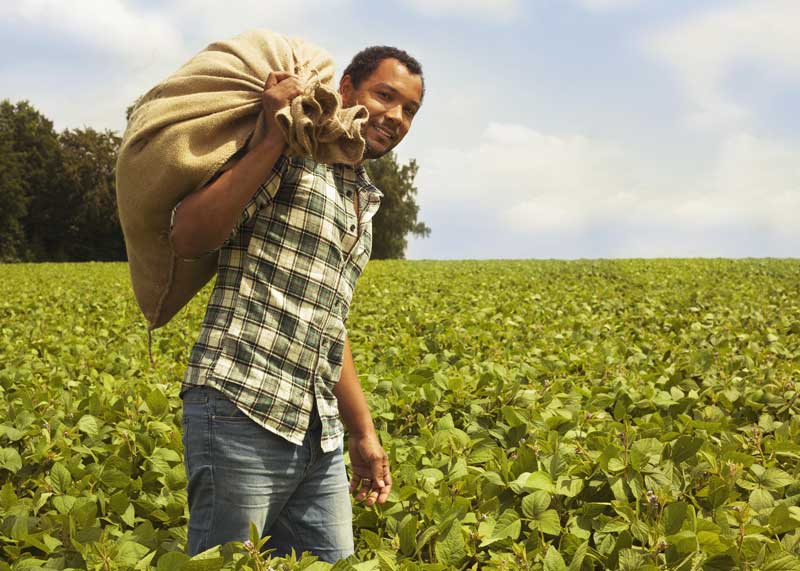
In this guide, we’ll cover the most popular types of Brazilian coffee beans, flavor notes, grading, and processing. Plus our picks for the best coffee brands from Brazil.
We’ll also cover the primary coffee regions of Brazil (home to countless coffee farms) and the ingenuity of the people who work these farms to produce large quantities of coffee for the world.
But first, here is the history of Brazilian coffee production.
Scandalous History of Brazilian Coffee
Coffee is not a native Brazilian plant. Francisco de Melo Palheta, a Portuguese diplomat, is credited with planting the first coffee bush in Pará, Brazil in 1727. The Portuguese had been looking for a way to enter the coffee market.
They were unsuccessful in obtaining seeds from neighboring French Guiana due to its Governor’s refusal to export the seeds.
However, when Palheta was on a diplomatic mission to French Guiana to resolve a border dispute, he had a secret relationship with the Governor’s wife. She sent him a bouquet spiked with coffee seeds, which he brought back to Brazil.
Over the years, coffee production spread from Pará to Rio de Janeiro, at first fueled by slave labor and then by paid workers.
By 1840, Brazil had become the largest coffee producer in the world – a position it has not yet relinquished.
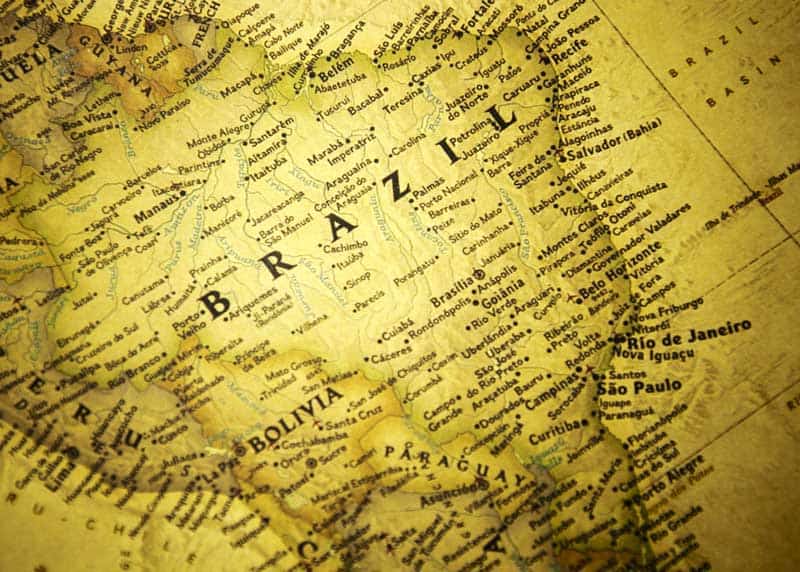
32 Coffee Growing Regions of Brazil
In Brazil, while vast areas of land are devoted to farming coffee, many of these areas do not exist at ideal altitudes for growing high-quality beans. This causes coffee cherries to ripen at different rates.
When cherries are handpicked, this is not a problem because a discerning farmer can pick only the ripe cherries.
But in Brazil, a lot of coffee farms are harvested using machines. This means that a large quantity of cherries are picked efficiently. But this also means that the quality of the harvest may not be as high as it is on farms harvested by hand.
To combat this, some farms have built custom harvesters to pick only the ripe coffee cherries (see video below of Daterra Coffee Farm). This leaves the unripe berries behind to further ripen.
The Brazil Specialty Coffee Association identifies 32 regions spread over 14 states that produce coffee.
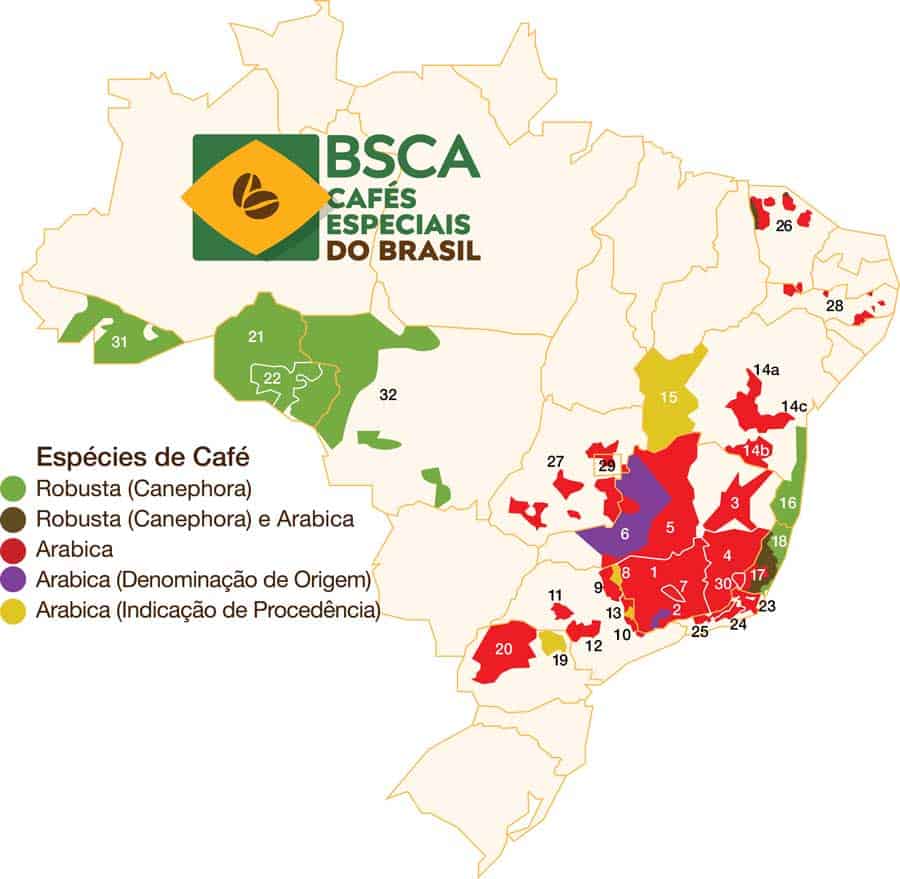
So while there are 32 regions in 14 states that produce coffee, just 4 of these Brazilian states produce 90% of Brazilian coffee.
1. Minas Gerais
Within the Minas Gerais, the main coffee-producing region is the Sul de Minas. This region has a high altitude and mild temperatures. It’s small coffee farms supply 30% of Brazilian coffee.
2. Espirito Santo
Although there are a few Arabica coffee farms in the south, Espírito Santo is the largest producer of robusta in Brazil. Here coffee is grown on small family farms that are committed to producing high-quality coffee, even if the yield is low.
This is a region that has high humidity, resulting in the slow and uneven maturation of coffee cherries.
The families who work the coffee farms here often pass through their fields five- or six times during harvest to hand-pick ripened cherries.
Because of the high humidity of the region, it means that “coffee in Espírito Santo must be depulped to yield higher quality”.
3. São Paulo
Most Brazilian coffee is exported from the Port of Santos in São Paulo. The Mogiana region which produces a large portion of the coffee from São Paulo has uneven terrain, high altitudes and mild temperatures.
4. Bahia
This state was the latest addition to Brazil’s coffee-producing regions. Beginning in the 1970s, this region is known for the use of new technologies and irrigation to produce high-quality coffee.
Its Cerrado and Planalto regions boast high productivity thanks to the introduction of technology, which helps in keeping costs low.
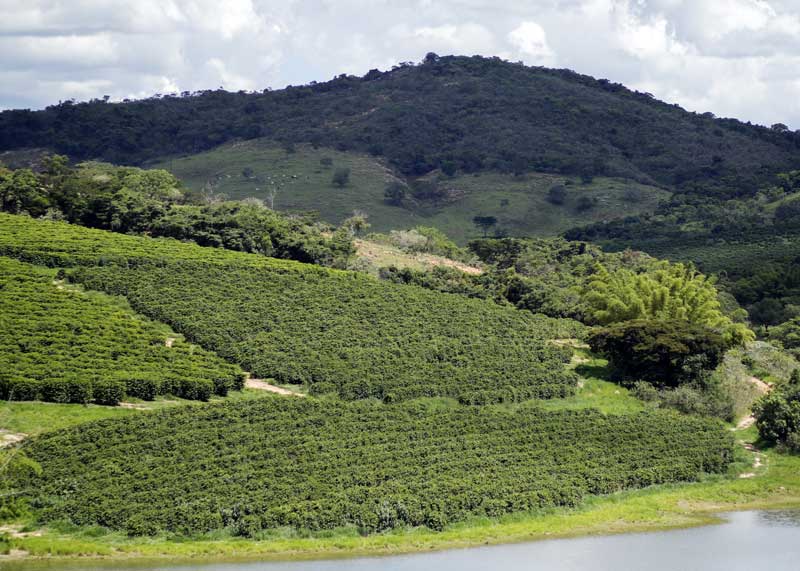
Which Country Grows the Most Coffee?
Brazil is the world’s largest producer of coffee. Annually, Brazil exports 2,652,000 metric tons (5,714,381,000 pounds) of coffee beans. This translates to 44,200,000 bags (60 kilograms per bag) of coffee beans. Source.
Following Brazil, other main exporters are Vietnam, Colombia, Indonesia, Ethiopia, Honduras, and India.
How Brazil Makes Over a Third of the World’s Coffee
In the following video, get a glimpse of coffee production in Matas de Minas.
Learn more about the 4 types of coffee beans.
Brazilian Coffee Beans & Flavor Notes
The are several uniquely Brazilian coffee beans:
- Bourbon, including the sub-varieties of red (Bourbon Vermelho) and yellow (Bourbon Amarelo)
- Caturra, a natural mutation of Bourbon
- Catuaí, a hybrid of Mundo Novo and Caturra
- Maragogype, is a natural mutation of the Typica varietal
- Mundo Novo, a hybrid of Typica and Bourbon
Brazilian coffee has a range of chocolatey, nutty flavors. It is smooth, full-bodied, and tends to have low acidity. This allows manufacturers of specialty coffees to use it effectively in their coffee or expresso blends.
Brazil also produces some high-quality, specialty-grade coffee that can contain subtle citrus notes and other brighter fruit characteristics.
Here’s more about how to describe coffee like a pro.
How are Brazilian Coffee Beans Processed?
Coffee cherries in Brazil are typically processed in one of three ways:
- Natural Process (Dry): Brazil’s climate lends itself to dry processing, which involves drying the coffee cherries in the sun until they are hard and black.
- Semi-Washed (Pulped Natural): This method is sometimes utilized to speed up the drying process and improve quality in humid regions. Rather than just leaving the cherries to dry in the sun, the cherry skin is removed by machine. After that the mucilage is left to dry and processed further.
- Fully Washed (Wet): This process has widespread use in the Bahia region. The coffee cherries are pulped, fermented and washed before they are set out to dry.
A new process called re-passed (raisins) may also be emerging as a coffee processing method in Brazil.
Visit to a Brazilian Coffee Farm: Daterra Coffee Farm
See how coffee is sustainably produced in Brazil at the Daterra Coffee Farm.
Brazil’s Special Coffee Grading System
The Brazilian Official Classification (Classificação Oficial Brasileira, or COB) provides the internal grading system for Brazilian Coffee.
This system developed over years based on business practices in Brazil and was codified (link opens pdf, in Portuguese) by the federal government in 2002.
According to the Coffee Business Services & Academy:
“The COB ascribes a number to a coffee lot, depending on the number of defects in a 300g sample. The lower the number, the less defects, and the better quality. So, for example, Type 2 coffee is better than Type 4.“
The coffee is then further classified according to the cup:
- Group I: highest quality arabica with no rio cups
- Group II: rio-cupping arabica which has an iodine taste
- Group III: conillon (robusta)
For the export market, these internal grades are translated into more standard grading systems such as the Green Coffee Association of New York’s system.
5 Best Brazilian Coffee Brands
Daterra Farms is probably the most well-known coffee brand from Brazil. In 2018, Swiss barista Emi Fukahori, won the World Brewers Cup (manual coffee brewing) using a Brazilian bean from Daterra Farms.
The company is also known as an industry leader for its sustainable practices.
In addition, we recommend the following Brazilian coffees:
- Volcanica Yellow Bourbon
- Coffee Bean Direct Dark Brazilian Santos
- Peet’s Coffee, Brazil Minas Naturais (K-Cup)
- Dark Brazilian Cerrado Coffee by Fresh Roasted Coffee
- Pilao Coffee Medium roast, very fine grind
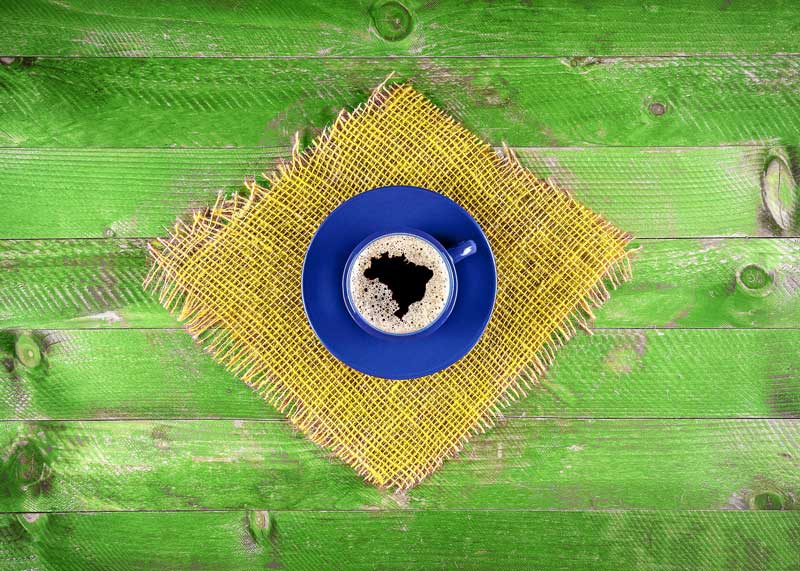
10 Interesting Brazilian Coffee Facts
- Brazilian athletes sold coffee to pay for their trip to Los Angeles for the 1932 Olympics.
- In Brazil, children also drink coffee.
- Cafezinho – a small cup of black coffee – is consumed nationwide.
- In Brazil, frost is a possibility on coffee farms.
- The total land area of Brazil devoted to growing coffee is about the size of Belgium.
- Small coffee farms (covering less than 25 acres) account for 71% of coffee farms in Brazil.
- Slavery is illegal in Brazil, but some coffee farm workers still face work conditions akin to slavery
- Brazil is the world’s largest producer of coffee.
- The United States is the leading importer of Brazilian coffee.
- Raw coffee cannot be imported into Brazil.
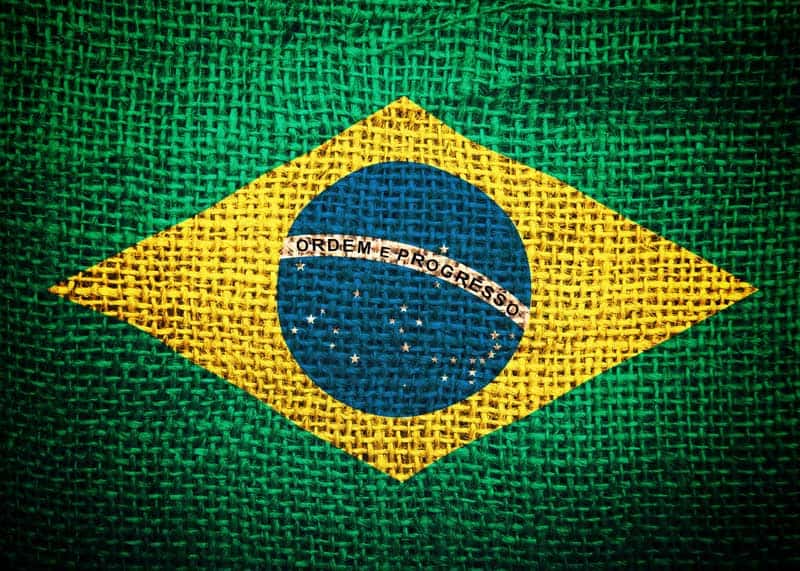
In case you’re wondering, here’s why coffee is known as java.
Brazil is the largest producer of coffee in the world. Mostly, Brazilian coffee is ideal for use in blends and expresso. Still, it is possible to find high-quality single-bean coffee among the diverse varieties of coffee exported by Brazil.
Now that you know so much about Brazilian coffee, you can ponder where your beans originally came from and how they were processed with every sip!
- About the Author
- Latest Posts
Dena Haines is a co-founder and blogger on EnjoyJava – and is working to make it the best coffee blog in the world.
She also blogs about travel at Storyteller.Travel and photography at Storyteller Tech. Dena is a partner at Storyteller Media, a publishing company she started with her husband, Bryan.


Michele
Sunday 31st of January 2021
I’m looking for a little advice. Looking for Brazilian coffee that has absolutely no after taste. Light to medium Roast!